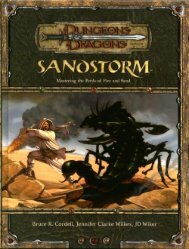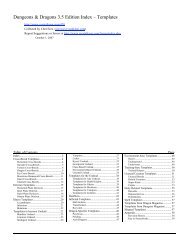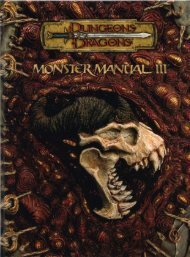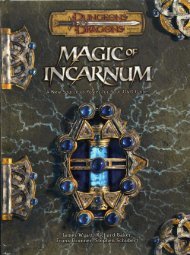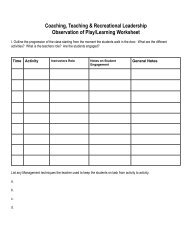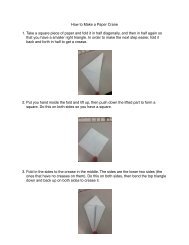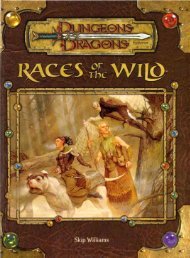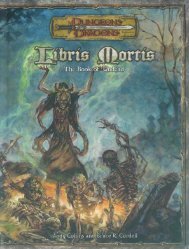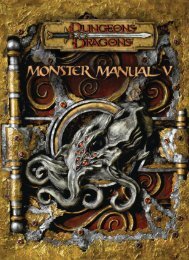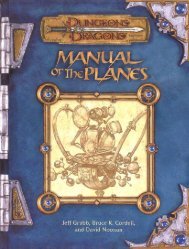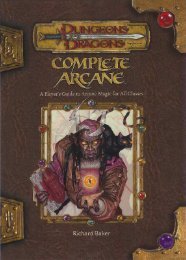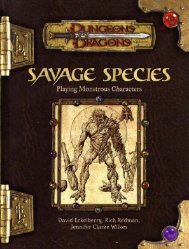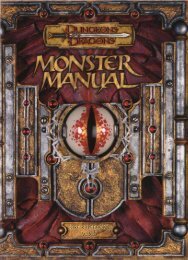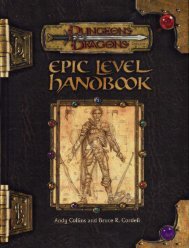Exemplars of Evil
Exemplars of Evil
Exemplars of Evil
You also want an ePaper? Increase the reach of your titles
YUMPU automatically turns print PDFs into web optimized ePapers that Google loves.
CHAPTER 4<br />
CAPTAIN<br />
GNASH<br />
is a pile <strong>of</strong> identical drawings, each depicting a huge black<br />
disc with smudged edges.<br />
Gnash spends much <strong>of</strong> his time here, leaving the day-today<br />
operation <strong>of</strong> the ship to his first and second mates. He<br />
writes nonsense on the walls or hunches over his desk, wildly<br />
sketching new pictures <strong>of</strong> the Eater <strong>of</strong> Worlds. If the Much<br />
Kill comes under attack, he bursts out <strong>of</strong> his quarters to direct<br />
the crew’s response.<br />
6. Wardroom: This room serves as the <strong>of</strong>ficer’s mess.<br />
Captain Gnash, Pog, and the other <strong>of</strong>ficers take their meals<br />
here, and except for Gnash, they all spend time here when<br />
not on duty. The room holds little more than a large table and<br />
six chairs. At any given time, the table holds the remains <strong>of</strong><br />
the last meal or two.<br />
7. Galley: The galley is a chamber <strong>of</strong> horrors. Arms,<br />
legs, and torsos hang from hooks set in the ceiling. A<br />
butcher block stands in the center; a huge, stained knife<br />
is stuck into it. The floor is sticky with gore, and bold<br />
dire rats snatch morsels as they slough <strong>of</strong>f the bones. The<br />
ship’s cooks, a pair <strong>of</strong> pseudonatural hobgoblins (see page<br />
75), pass time arguing over the finer points <strong>of</strong> roasting<br />
human flesh.<br />
Dire Rats (2d4): hp 5 each (1 HD); MM 64.<br />
8. Pog’s Quarters: When he is not navigating on the<br />
stern castle or taking meals in the wardroom, Pog stays in<br />
his quarters. He tolerates the crew well enough, but has no<br />
affection for them or their deformities. The room is sparsely<br />
furnished with a bunk, a small chest <strong>of</strong> spare clothes, and a<br />
padded chair. Aside from the possessions mentioned in his<br />
statistics block, Pog owns nothing <strong>of</strong> value.<br />
9. Fecar’s Quarters: This appalling room makes the galley<br />
seem pleasant by comparison. It is stripped <strong>of</strong> everything<br />
but a darkly stained mattress on the floor. The walls, floor,<br />
and ceiling are splashed with gore, on which maggots dine<br />
and flies drop their eggs. Fecar sleeps here when he must,<br />
but otherwise spends most <strong>of</strong> his time elsewhere.<br />
10. Brig: This filthy chamber holds prisoners until Gnash<br />
is ready to sacrifice them to the thing in the hold. The<br />
floor is covered with old straw and excrement, and a sludgecaked<br />
bucket sits next to the door. Captives are never fed,<br />
since Gnash does not waste food on something he intends<br />
to kill anyway.<br />
11. Crunglutch’s Quarters: A simple cabin equipped<br />
with a bunk, desk, lamp, and chair, these quarters hold little<br />
<strong>of</strong> interest. As with the first mate, Crunglutch is frequently<br />
busy and rarely in his quarters.<br />
12. Chain Locker: This room holds a long coil <strong>of</strong> heavy<br />
chain, which passes up through the ceiling and onto the forecastle,<br />
where it is attached to the anchor. Additionally, spare<br />
sails, coils <strong>of</strong> rope, and other supplies clutter the floor.<br />
72<br />
pqqqqqqqqqqqqqqqqqqqqrs<br />
SHIP STATISTICS<br />
The Much Kill is a beefed-up version <strong>of</strong> the caravel—a relatively<br />
advanced type <strong>of</strong> sailing ship. The statistics block presented<br />
here summarizes the most important characteristics <strong>of</strong> the<br />
ship for use in a combat situation. The Stormwrack supplement<br />
contains much more information on waterborne vessels.<br />
Much Kill<br />
Colossal caravel<br />
Seaworthiness +4<br />
AC section 3, rigging 1<br />
Hull Sections 48 (sink 12)<br />
Section hp 120 (hardness 8); Rigging hp 80 (hardness 0)<br />
Speed wind × 30 ft. (average)<br />
Melee ram (6d6)<br />
Ranged 4 +1 ballistae (3d8/19–20)<br />
Mounts 4 light<br />
Space 120 ft. by 20 ft.; Height 20 ft. (draft 20 ft.)<br />
Complement 60; Watch 14<br />
Cargo 240 tons<br />
Rigging hp: The number <strong>of</strong> hit points and the hardness <strong>of</strong><br />
each rigging section.<br />
Melee: The damage dealt by the vehicle per 10 feet <strong>of</strong> speed<br />
it currently possesses if it rams another object. For example, a<br />
ship with a base ram damage <strong>of</strong> 6d6 deals 6d6 points <strong>of</strong> damage<br />
if moving at a speed <strong>of</strong> 10 feet, 12d6 at a speed <strong>of</strong> 20 feet, and<br />
so on.<br />
Ranged: The damage dealt by any projectile weapons the ship<br />
possesses. The attack bonus for a ranged attack is based on the<br />
creature operating the weapon, modifier for the difference in size<br />
between the weapon and the creature. In the case <strong>of</strong> a ballista (see<br />
DMG 100), which is a Huge weapon, a Medium creature takes<br />
a –4 penalty on its attack roll when operating the weapon.<br />
Mounts: The number <strong>of</strong> weapons the ship can mount. A light<br />
mount is suitable for a ballista. (The Much Kill has four ballistae,<br />
two on the forecastle and two on the sterncastle.)<br />
Space: The length and width <strong>of</strong> the area taken up by the ship.<br />
Height: The height <strong>of</strong> the main deck above the waterline. Most<br />
vessels <strong>of</strong> Huge or larger size have deckhouses, forecastles, or<br />
sterncastles that are above this level.<br />
Draft: The amount <strong>of</strong> the ship’s overall height that lies below<br />
the waterline.<br />
Complement: The number <strong>of</strong> crewmembers, passengers, and<br />
soldiers who can be carried by the vessel for extended voyaging.<br />
For a short voyage (a day or less) a ship might be able to cram<br />
two or three times this number <strong>of</strong> individuals on board.<br />
Watch: The number <strong>of</strong> crew members necessary to make<br />
course changes, adjust for wind changes, and generally handle<br />
the ship. Usually the watch consists <strong>of</strong> a helmsman, a lookout<br />
or two, and a small number <strong>of</strong> deck hands who can go al<strong>of</strong>t to<br />
change the set <strong>of</strong> the sails as necessary.<br />
Cargo: The capacity <strong>of</strong> the vehicle’s hold, in tons (1 ton =<br />
2,000 pounds). Most ships are slowed to 3/4 normal speed if<br />
carrying half this load or more.<br />
Seaworthiness: The ship’s overall sturdiness. This modifier is<br />
applied to any Pr<strong>of</strong>ession (sailor) checks the captain or master<br />
makes in order to avoid foundering, sinking, and hazards that large,<br />
well-built vessels avoid more easily than small and frail ones.<br />
AC: The AC <strong>of</strong> each hull section (see below) and the AC <strong>of</strong><br />
the rigging (which comes into play when attackers are trying to<br />
eliminate or reduce a ship’s mobility).<br />
Hull Sections: The number <strong>of</strong> hull sections the ship<br />
possesses.<br />
Sink: The number <strong>of</strong> destroyed hull sections necessary to sink<br />
the ship outright.<br />
Section hp: The number <strong>of</strong> hit points and the hardness <strong>of</strong> each<br />
hull section.<br />
pqqqqqqqqqqqqqqqqqqqqrs



